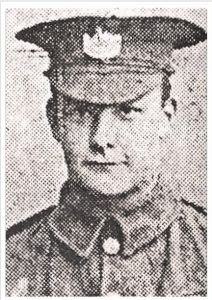10th Battalion, Gloucestershire Regiment

Charles Thomas Brain was born in Campden on 26 July 1896, the second son of John and Mary Katharine Brain of Watery Lane, and was baptised at St James’s Church on 6 September of that year. His father was an agricultural labourer.
At the age of 18 Charles enlisted in the Gloucestershire Regiment in September 1914. The next year was spent training in England before he arrived in France on 4 October 1915. He was posted to the 10th Battalion, which had just suffered heavy casualties during the Battle of Loos.
The battalion was still in the coal-mining region of northern France around Lens in June 1916 and the war diary remarks that the chief incident of note was when British miners exploded two mines under the German trenches in front of the battalion’s lines. The second of these two mines formed a crater and the battalion occupied the near lip, which was shelled somewhat persistently by the enemy, causing a number of casualties. The end of the month was spent in reserve in preparation for a move south to the Somme.
The battalion arrived at Doullens by train and then marched to billets in Naours, arriving on 6 July. They rested all day in their billets befor they marched at night to billets in Pierregot, beginning their gradual move to the front and the Somme battlefield. On the evening of 7 July they marched further forward to Baizieux Wood, where they bivouacked for the night. They arrived at billets in the town of Albert at midnight on 9 July. The next day they moved up to the frontline at The Dingle, about one mile north of Fricourt. The ground occupied had only just been won from the Germans and was strewn with corpses, between four and five hundred of which the battalion buried. The next few days they were mainly employed in improving existing defence works and digging fresh communication trenches to Contalmaison, which had just been won from the enemy.
On 14 July the battalion arrived back in Albert before they moved forward to Becourt Wood. On 19 July trenches were occupied in the vicinity of Shelter Wood, one mile south of Contalmaison, and the next two days were spent providing working parties to dig a new front line in front of Bazetin-le-Petit Wood, which had just been captured from the enemy.
On 21 July the battalion moved up to the front line trenches opposite and due south of Martinpuich. That night was spent digging a new front line about 160 yards in front of the trench that had been dug the previous night. The next day was spent in improving the advanced front line, which was going to form the kicking-off point for the attack that the battalion had been ordered to make early on the morning of 23 July.
At 12.30am on 23 July they attacked a portion of the new German Switch Line in front of Martinpuich. They failed to take their objective but they did capture Point 17 and from this position it was possible to observe the enemy’s line for the Yirst time. During the attack the battalion lost 147 casualties, including Charles and his brother, William. Their bodies were never recovered after the war but their names are recorded on the Thiepval Memorial. Charles was 19 years old when he died and his name is recorded on two memorials in Campden: in St James’s Church and in the High Street.
Extract from Campden 1914-18 by Paul R Hughes
